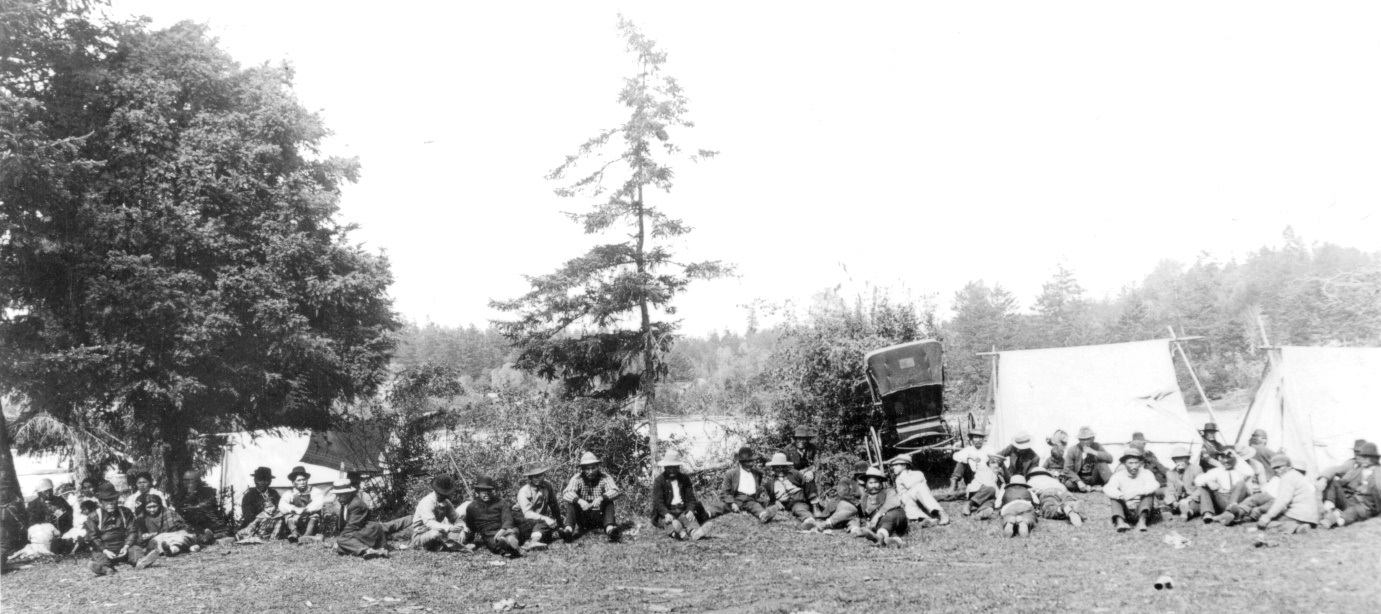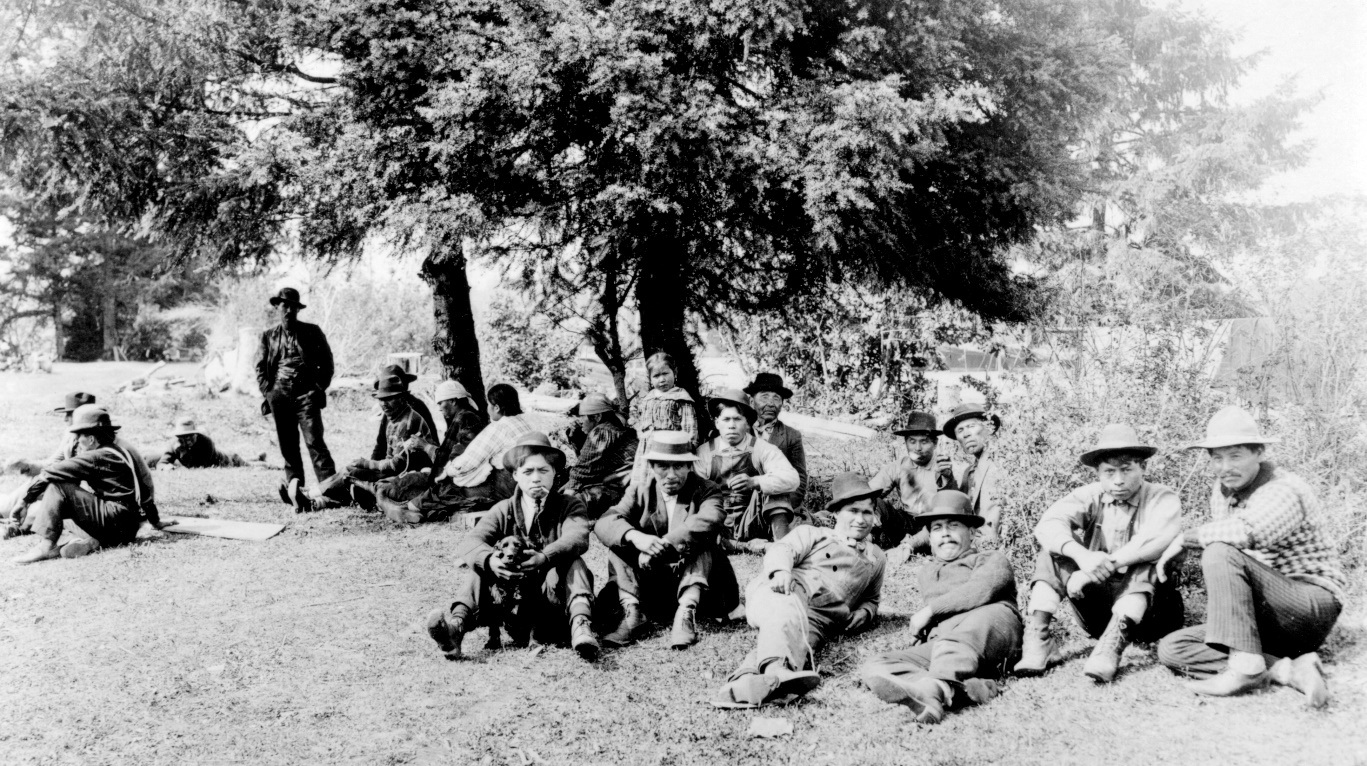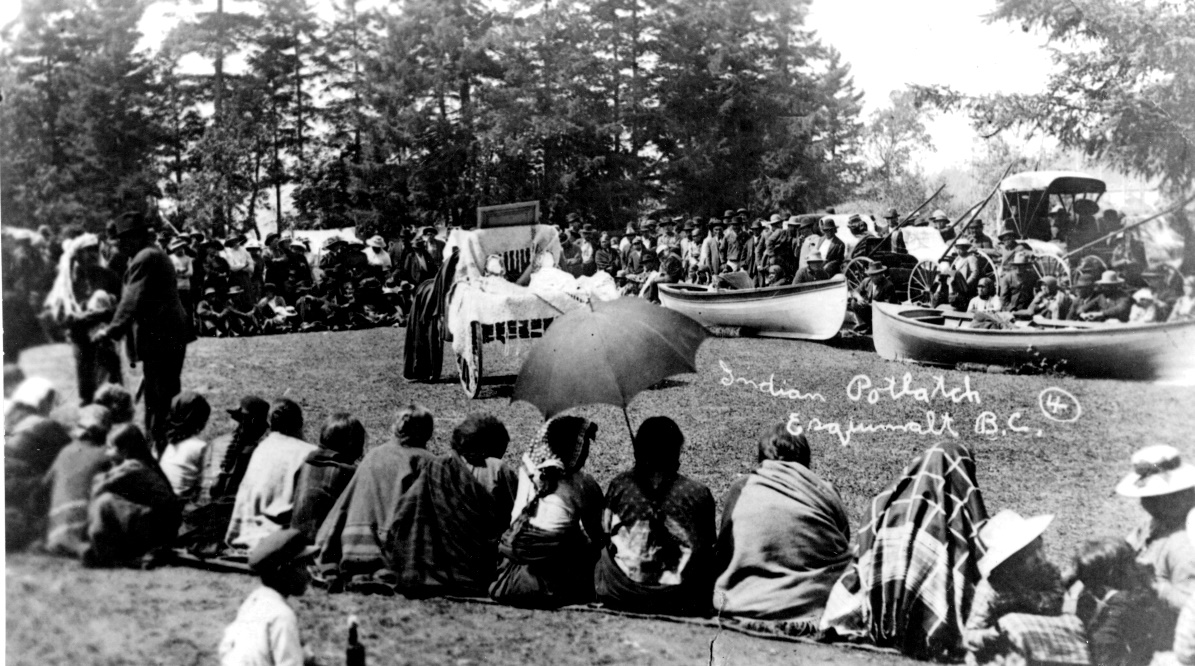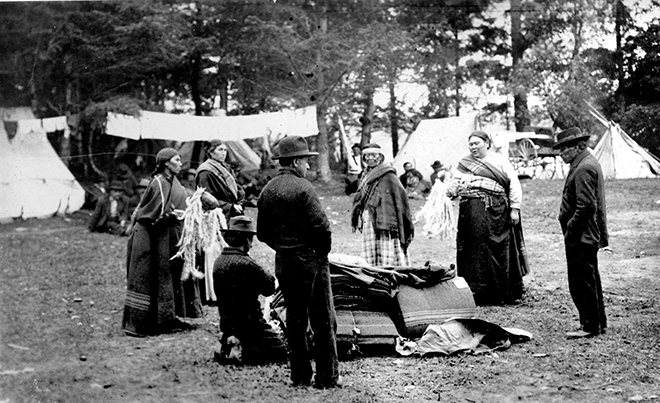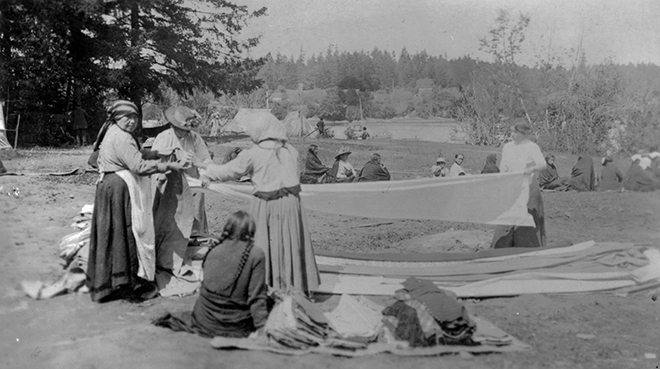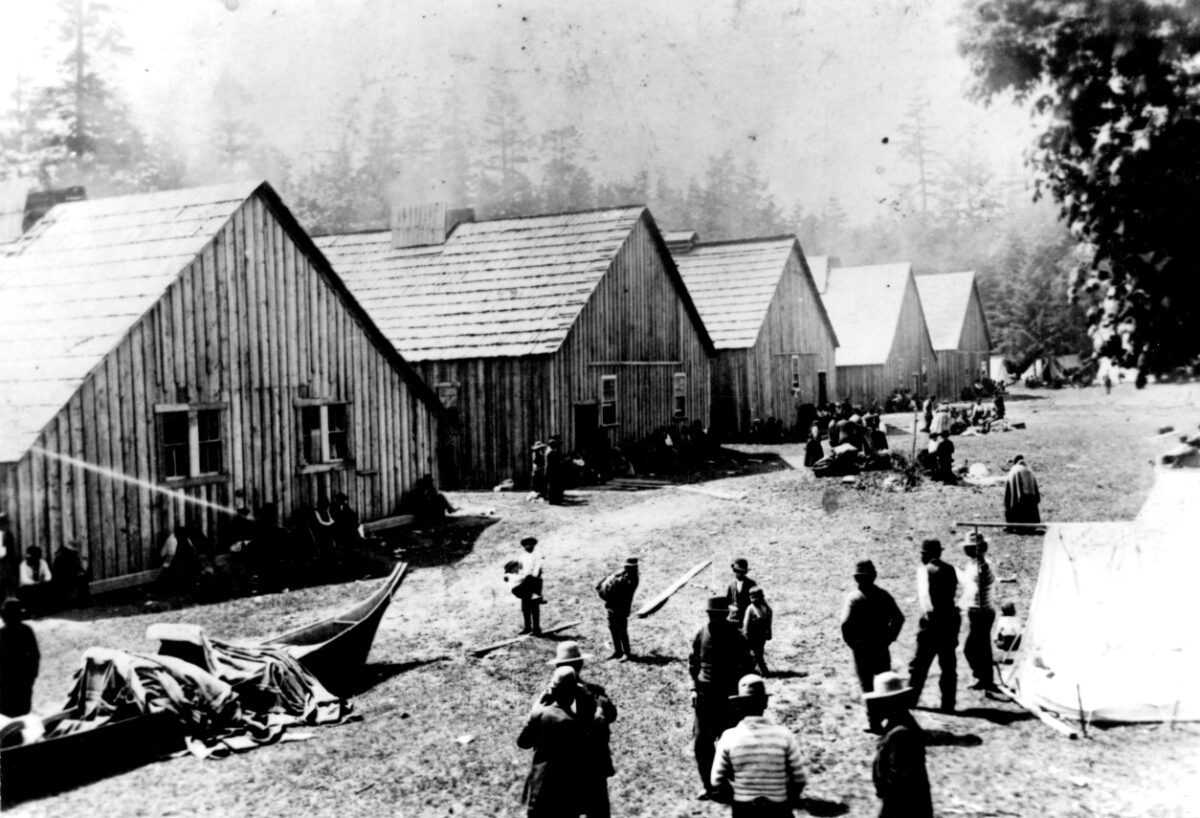The Great Songhees Potlatch of May 16-27, 1913.
In 1911, the Songhees moved from their historic period reserve in the inner harbour (1844-1911) to a new reserve above Esquimalt Harbour where European style houses were built.
At Maplebank, along the waterfront, five new buildings were constructed, commonly called Long Houses or Big Houses. These were a blend of both traditional and European style house construction, and used mostly for activities such as social gatherings and canoe building. Figure 1, shows the five new longhouses owned by: Left to right: Chief Michael Cooper; William Roberts; Jimmy Fraser; Jimmy Johnny; jointly owned by Alex Peter and Jack Dick.

Chief Michael Cooper and representatives of Songhees families held a series of Potlatches over a period of ten days in 1913, with money gained from the transfer of their old reserve in Victoria Harbour. They were celebrating the recent building of houses and the new granite monument honouring their ancestors, erected in their cemetery on the new reserve. Burials from the Old Songhees Reserve were moved to this location.
The Songhees had the long experience of knowing how to get results from their experience with both the Provincial, city and Federal governments in negotiating the movement from the Old Songhees Reserve and other matters (Keddie 2003).
The Songhees continued to keep a connection with officials of the Indian Lands Commission, inviting them to view the new reserve. In 1912, the Songhees saw that it was important for them to be seen and to make a connection with the King through his representative in the Canadian Governor-General. They put Provincial officials on the spot to ensure that this happened. This is clearly seen in Chief Cooper’s public letter published in The Daily Colonist on September 17, 1912. The Songhees also had the strategy of planning on having large scale potlatch events that would occur at the same time as the visiting Lands Commission and Queen Victoria’s birthday celebration of May 27 of 1913.
Reports of the time put the number of invited guests to the Potlatch events in a range between 700 and 1100. Visitors included Indigenous peoples from the La Conner and Lummi reserves in Washington State. From B.C. visitors attended from Nanaimo, Chemainus, Valdez Island, Cooper Island, Somenos, Quamichan, Komiaken, Cowichan, North, West and South Saanich, Klemklemalitch, Sooke, Becher Bay, Nitinat, Clo-oose and other reserves.
I will include here the newspaper accounts, presented in sequence, at the time of these important events, and to show the newspapers colonial perspective of the time. The photographs of the events usually have no documentation and are lacking details here. I recognize a few individuals in the images, but enhanced photography in the future will add more to the story of the events.
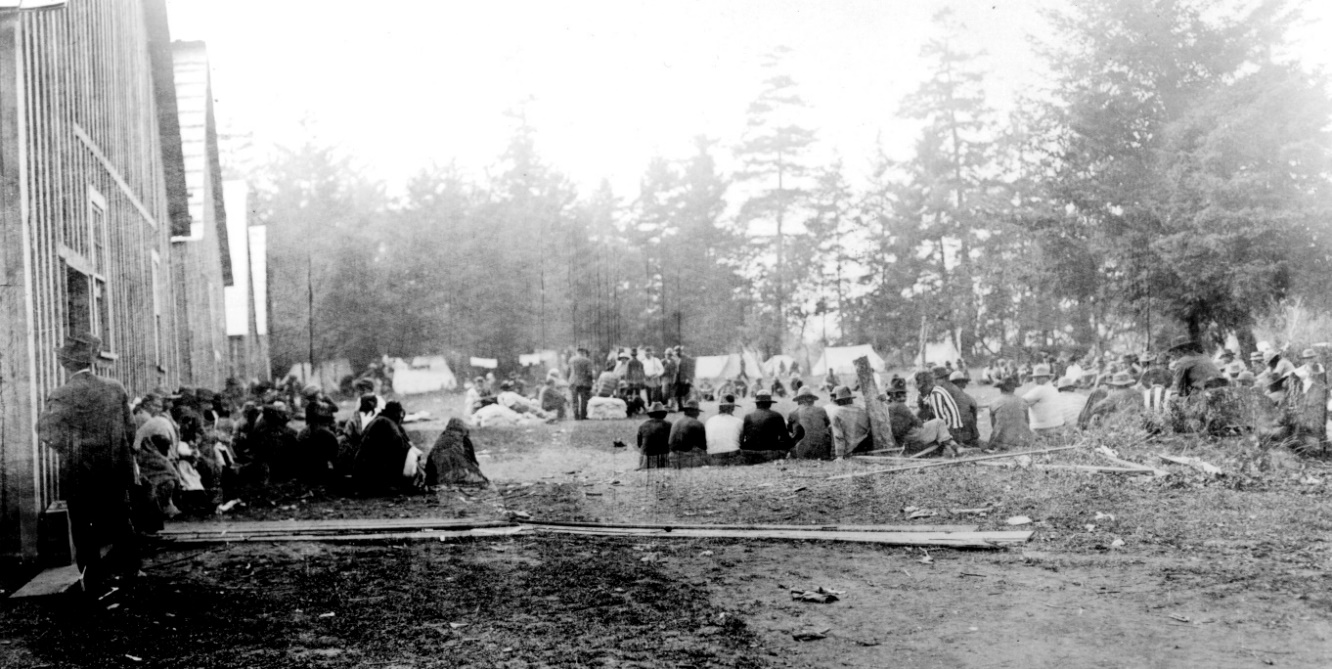
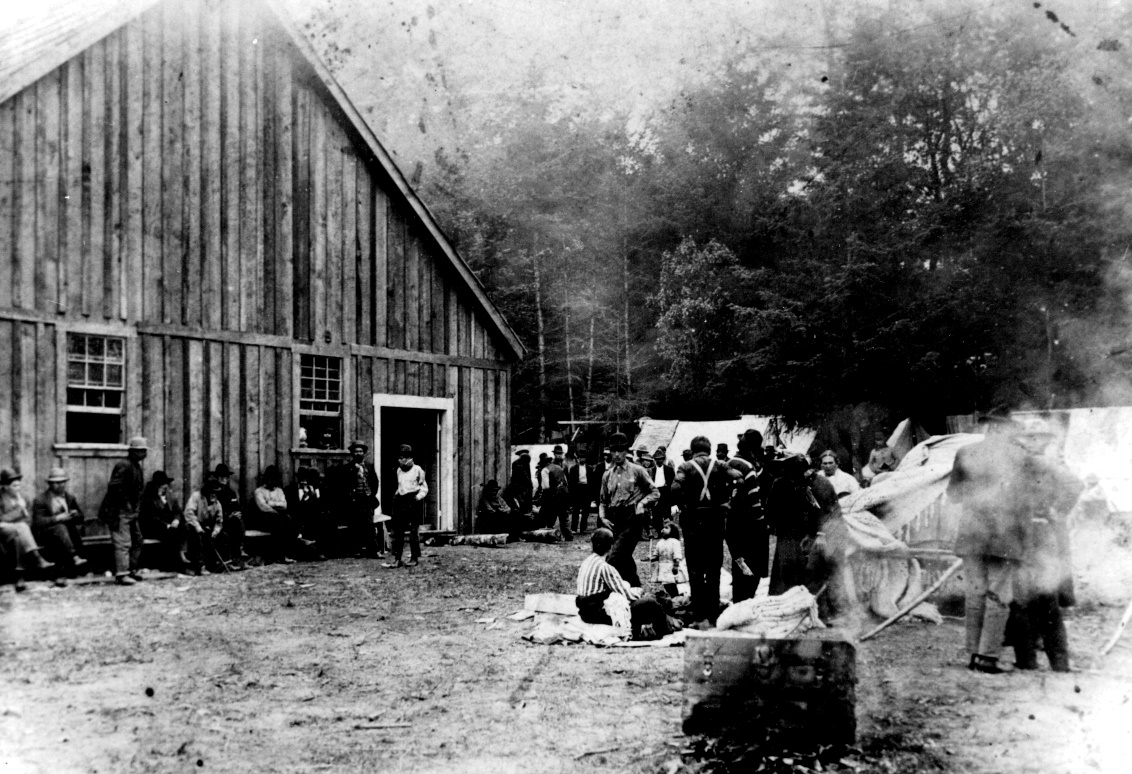
“Songhees Indians Express Loyalty”
Desire Honor of Visit from His Royal Highness – Grateful for Sir Richard McBride’s Consideration.
It is the wish of the Indians of the Songhees tribe that when His Royal Highness the r-General comes here he may be given an opportunity to visit the new reserve at Esquimalt and be in a position to tell the great King whom he represents in the country how happy and contented they are in the home which they have been given through the stateman-like action of the premier in connection with the settlement of the reserve question.
Some little time ago Chief Michael Copper, on behalf of the tribe, forwarded a letter to Sir Richard McBride requesting his good offices in the direction of having his Royal Highness visit the reserve. This communication was sent on to the lieutenant-governor, that being the only official way in which the government ca approach the governor general, and while there has been no appointment made in the itinerary which has been drawn up for the royal visit to the capital, and the request of the Songhees will not be communicated to His Royal Highness until has arrival her, there is no doubt that he will be graciously pleased to grant the desire of this loyal tribe.
The visit will be arranged to take place while the royal party is motoring about the city and vicinity, probably in conjunction with a visit to the defenses at Esquimalt, which it is known that His Royal Highness intends to make. Chief Cooper’s letter to Sir Richard McBride was as follows:
‘Dear Sir Richard, – We learn with great delight that H. R. H. the Duke of Connaught will shortly visit the city. Would it be possible for H. R. H. to do us the honor of a visit? We are most anxious that H. M. King George shall, through the governor-general, know of our deep devotion to our beloved king.
We wish, in our humble manner, to express our loyalty to the empire and we shall feel deeply indebted to you if you will, through your great kindness, arrange that His Majesty’s direct representative will grant to us the extreme pleasure of paying our respects to H. M. King George the Fifth.
We wish at this time to publicly thank you for the broad consideration that has for the past two years been extended to the Songhees tribe. It is to you that we owe our everlasting gratitude. You have done more for us than we could reasonably expect; in fact, your promises have been mor than fulfilled, and it is with a feeling of deep respect that I convey to you the best wishes of the band.
I am, dear Sir Richard, Yours sincerely, Michael Cooper, Chief of the Songhees.” (The Daily Colonist of September 17, 1912, page 11).
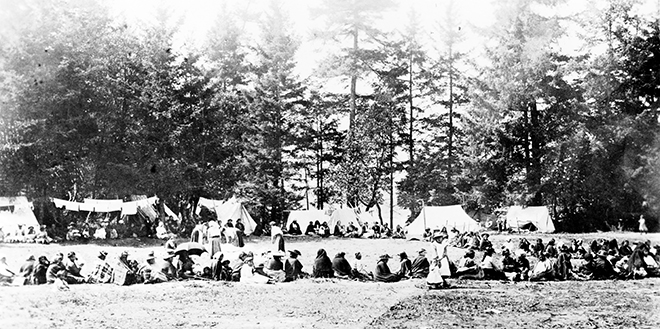
“Songhees Indians Testify Loyalty. His Royal Highness Visits New Reserve at Esquimalt – Inspection of Land Forts and Warships”.
“His Royal Highness the Duke of Connaught, accompanied by his suite, paid a visit to Esquimalt and the fortifications yesterday morning, also driving through the Songhees reserve.
The visit was a semi-private one, being confined to the viceregal party and the officers of the navy and militia in charge. Upon arrival the duke was met by Colonel Wadmore and first made an inspection of the land forts. Then he proceeded to the dockyard where he was met by the senior naval officers, Commanders Hose and Walters, and a visit was paid first to H. M. S. Rainbow and later to H. M. S. Shearwater, the crews of each manning the ships in honor of the distinguished visitor. After an inspection of the casting shop, the party boarded the tender Beryl and were conveyed to Rod Hill where four live shells were fired from the disappearing 6-inch guns at a 5,000, yard target.
Visits the Songhees
His Royal Highness drove through the Songhees reserve and made a careful inspection of the conditions under which the Indians live. A stop was made at the residence of Chief Michael Cooper, which was decorated with flags in honour of the occasion, and about 50 men, women and children were presented to the uncle of the great white father, who shook hands cordially with each one of them. In addition to the Songhees Indians, there were present Chief Simpaymult of the Cowichan reserve, with fifteen members of his band, and Chief George of Klem-Klemi-lish.
The Indians expressed their keen delight that the duke should have visited them in their new home, to see for himself how comfortably they are located as a result of the wise policy of Sir Richard McBride and his associates.” (The Daily Colonist October 1, 1912, page 14).
“To Honor to Their Ancestors. One Day to Be Set Apart Next Week at Annual Potlatch to Celebrate Erection of Monument in New Cemetery”.
This year the gathering of the different nations of Indians at their rendezvous on the reservation on Esquimalt Harbor will possess more interest than usual, inasmuch as the Songhees tribe will set one day apart for a celebration of the monument which they have raised in their cemetery on the new reserve to the memory of their ancestors, whose remains have been brought from their former resting place to their present graves.

Chief Cooper was found yesterday down by the big Indian houses at Maple Bay, which are being made ready for occupation next week, when the Indians of many a distant tribe are expected. Invitations have been issued to those of the La Conner and Lummi reservations in the Northwest Counties of the State of Washington, to those of Nanaimo, Chemains, Valdez Island, Cooper Island, Somenos, Quamichan, Komiaken, Cowichan, North, West and South Saanich, Klemklemalitch, Sooke, Becher Bay, Nitinat, Clo-oose and other reserves. This gathering will continue all through the next two weeks, and before it is dissolved the Indians will have an opportunity of being present and taking part in the regatta on May 24. But as Chief Cooper said yesterday, one of the great days will be that on which the Songhees Indians show to the other tribes the monument they have raised in their cemetery to their ancestors. The cemetery lies in a hollow high up behind the village, facing north across Portage Inlet and the Saanich Hills, In the centre is the granite monument brought from Scotland, round which the main drive circles. This is a cross on a column of red granite on a base of grey granite, and bears the inscription: ‘This monument was erected by the Songhees Tribe to the memory of their departed grandfathers and grandmothers removed here. Erected A. D. 1911.” (The Daily Colonist May 7, 1913. Page 11).
“Fine Monument to Memory of Dead Ancestors”
“The life of the Indian Reserve is now centered around the big buildings down on the shore of Esquimalt Harbour at Maple Bay. Fresh arrivals are coming in almost daily from the different reserves up the Island and already a large number of Indians are camped there, as may be judged from the fact that one baker in the neighbourhood delivered 1,000 loaves yesterday morning.
At present no programme has been drawn up for the proceedings of the next ten days., but Chief Michael Cooper and other of the chiefs are expecting on one day to meet the Indian Land Commission sent out by the Dominion Government, and on another day the Songhees Indians will formally show their visitors the imposing monument they have erected to the memory of their ancestors. Whose bones, brought across from the old reserve, now lie in the little cemetery overlooking the waters of Portage Inlet.” (May 14, 1913, p.14) .
“The Memorial”
“The cross of Peterhead Scotch granite (Figure 5) in the new cemetery on the Songhees Reserve to the memory of their ancestors by the Indians, was imported and set up by the Phillips Stone Works, of 1502 Fairfield Road” (The Daily Colonist, May 17, 1913, page 7).
On May 20, 1913, the Commission on Indian Lands in British Columbia met in Victoria. The procedures of the Commission had already been developed the previous year on September 24. The purpose of the Commission was “to investigate the condition of Indian affairs in British Columbia”. Four members of the Commission, two from each of the Province and Federal governments, were sworn in this day.
In the past local newspapers often reported in some detail on Indigenous potlatches on the Old Reserve in Victoria Harbour. Very little was reported on the specific events of the activities shown here on the New Reserve. The newspapers around this time were very pre-occupied with articles and disputes as to what to do with the property from the now vacated Old Reserve.
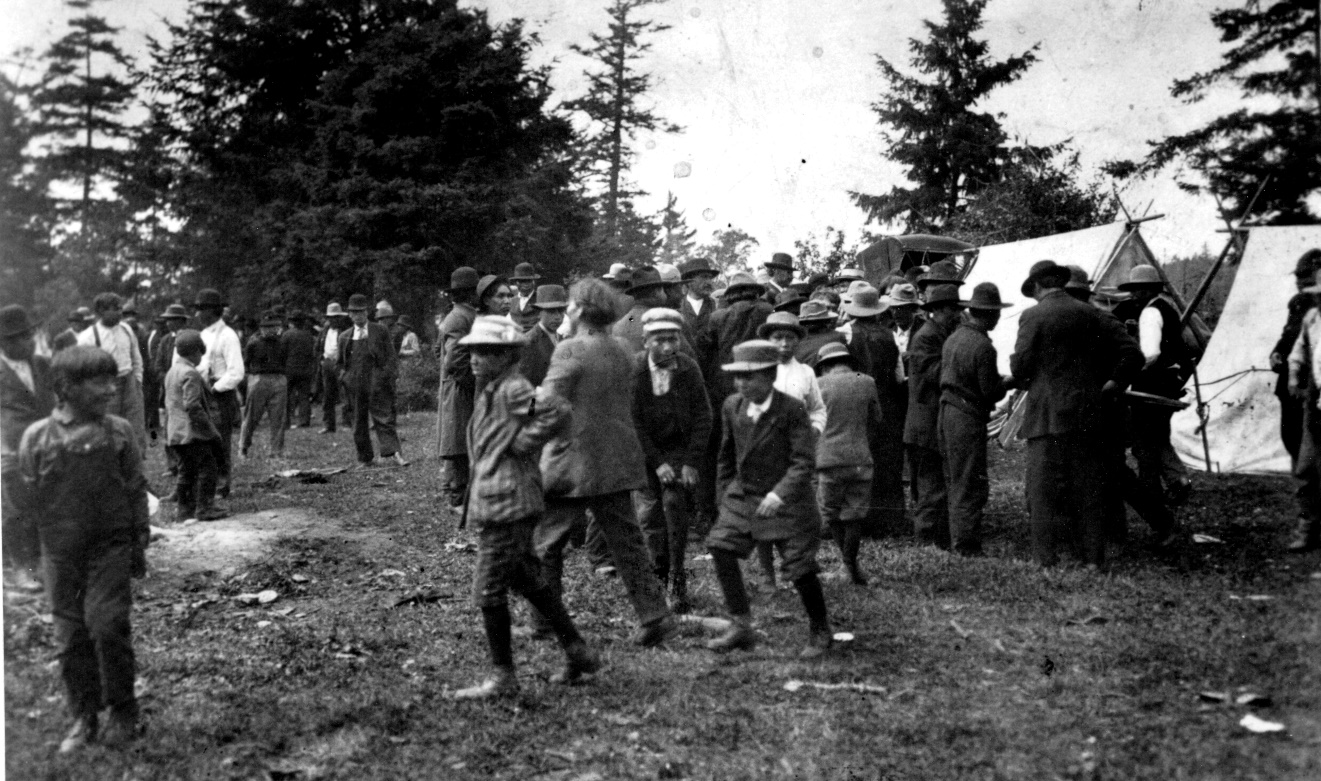
“Commissioners Pay Visit to Songhees”
“Guests of Chief Cooper Yesterday Afternoon on New Reserve on Esquimalt Harbor – To Duncan Monday”.
“A general consideration of the scope of duties covered by their commission, tentative plans of procedures, and preliminaries of organization occupied the members of the Indian Lands Commission all yesterday morning, the sitting being of private rather than public character of interest. No itinerary was completed, although it now seems virtually agreed, that time will scarcely permit of the suggested visitation of the reserves along the West Coast of Vancouver Island during the present summer. To arrange the itinerary for this important section of the Province, so that the Indians may be found at their home illahies and at the same variably situated holding, their modern and well furnished homes, their neat new schoolhouse now approaching completion, their tidy gardens and their seemingly complete adaptation of many of the commendable features of white civilization.
Welcome by Chief Cooper
At the council house the members of the Commission were welcomed by Chief Michael Cooper, who in a neat little speech expressed his appreciation of the honour paid his tribesmen in the visit, his and their contentment with their new surroundings, and his conviction that the Indians would now make the most of their greater opportunities for self improvement.
Hon. Mr. Wetmore replied, showing in his eminently practical references to conditions as they are found at the new home of the Songhees that he is a remarkably quick and close observer, as well as a profound student of human nature.
The opportunities within the grasp of the Indians were sketched by the veteran jurists and his terse, friendly address was listened to with very marked attention on the minds of the many natives present.
A visitation was afterwards paid the various parts of the reserve by all members of the Commission, announcements were made and duly interpreted as to commission arrangements as at present understood, several of the more important chiefs of the Island and Mainland were duly presented and introduced, and the Commission party left amid enthusiastic and long continued cheering which might be taken as a most happy augury of the good feeling of the native peoples toward the work which these distinguished gentlemen have been commissioned to perform in the interests of British Columbia and all sections of its population”.
“Inspected Monument”
“The homeward drive was broken by a visit to the little Indian cemetery, where Chief Cooper explained briefly the short histories of the departed leaders of his band, and the handsome monument that has been erected by the tribe to its remembered dead, as well as the distinctly neat and well-ordered appearance generally of the little God’s acre, evoked expression of decided commendation.
At noon yesterday Hon. Sir Richard and other Provincial Ministers, and the commissioners, were entertained at luncheon by the chairman Hon. Mr. Wetmore” (The Daily Colonist, May 21, 1913, page 5).
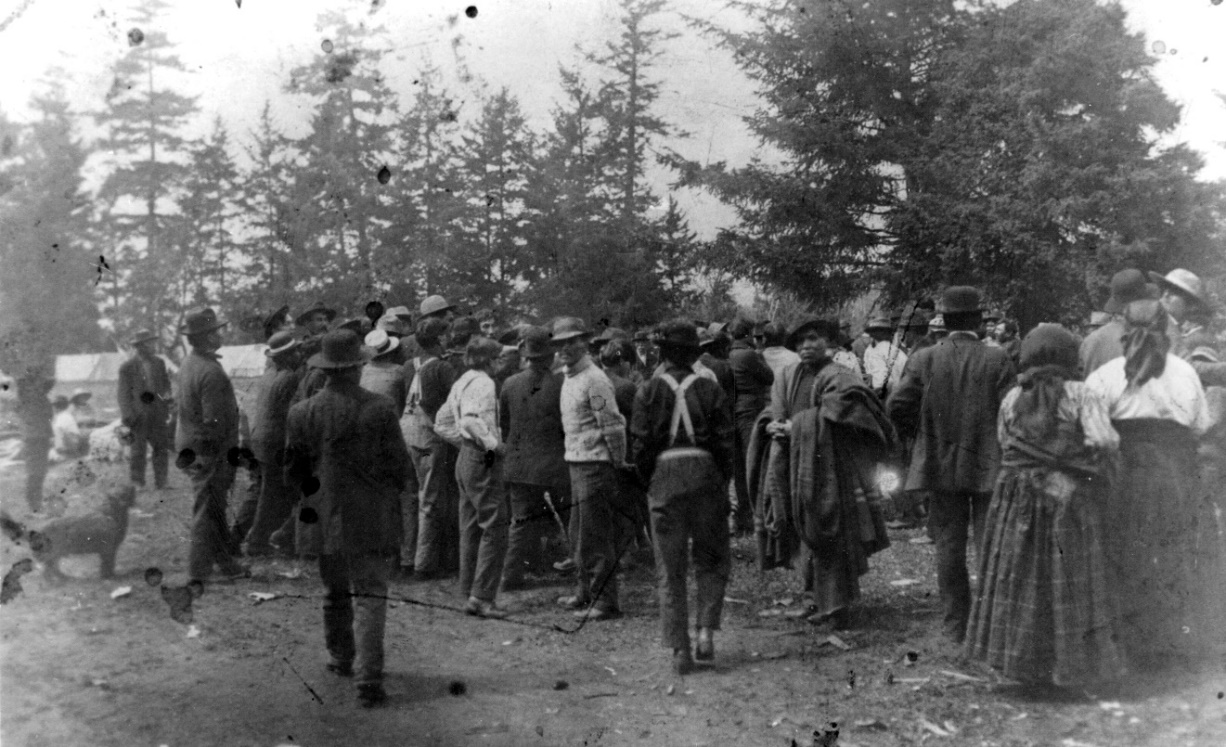
“A Harmonious Gathering. Chief Michael Cooper and the members of the Songhees tribe have during the past fortnight been entertaining some 1100 Indians from different parts of the Island. The gathering was perhaps the most harmonious which has ever taken place on the Island. There was not a single instance of any trouble having arisen. Dominion Constable O’Connell, of Nanaimo, and the Indian agent Robertson, of Duncan, who were present at the festivities at the Esquimalt reserve, speak in the highest terms of praise of the conduct of the Indians. Both of these officials have done much good work among the Indian tribes and occupy a prominent place in the regard of the natives. They are both excellent officers whose experience warrants every respect being paid to their opinions on the matters connected with the Indians. The latter, weather engaged in their celebrations on the reserve or visiting Victoria, as they did in large numbers, displayed the most exemplary behaviour, which has been the subject of very favorable comment by all those who came inContact with them.” (The Daily Colonist, May 27, 1913 p.4).
